Introduction
In the bustling landscape of pinoy contact centers, known for a warm customer-centric approach, a typical day for contact center agents unfolds with an array of challenges, including encounters with irate customers. Of course, such interactions are an unavoidable reality. The question arises: How does one effectively navigate these challenging moments? Equipped with the right tools, training, and contact center solutions, agents can deftly manage difficult personalities with poise and professionalism. In this article, we’ll explore some practical tips to help agents handle these situations smoothly, ensuring customer satisfaction remains a top priority even when things get tough.
Related must-reads:
- The ultimate guide on call center scripts and examples
- How to handle customer complaints – [+8 Examples]
- Call center software – A Complete Guide [2024]
- Customer service representative: Skills & Strategies
What are the potential triggers for customer frustration?
Without a doubt, customer satisfaction stands as a cornerstone of business success. However, the initial stride towards enhancing CSAT scores begins with grasping the fundamental reasons behind customer dissatisfaction Let’s first talk about scenarios that can lead to a frustrated customer:
Substandard customer support
Picture a customer facing a lengthy wait time, unhelpful email responses or lack of proactive follow-through when contacting customer support to check on his order refund. Or a customer reaches out to inquire about a product but receives inadequate responses or misinformation. Unhelpful or indifferent support representatives contribute to dissatisfaction, increasing the chances of a highly frustrated customer looking for escalation.
Subpar quality of product or service
Consider a scenario where a customer receives a defective product or experiences inconsistent service quality. Dissatisfaction arises when products fail to meet expectations, services lack consistency, or promised features fall short. This is one of the top reasons for irate customers.
Lack of Personalization
Customers expect customized experiences crafted to suit their individual requirements and preferences. Generic or impersonalized interactions leave customers feeling undervalued, emphasizing the importance of personalized recommendations and tailored customer service.
Discrepancy between pricing and perceived value
Customers seek value for their money, and a perceived disconnect between price and value can lead to dissatisfaction. Unreasonable price hikes, hidden fees, or misleading pricing strategies create negative experiences, highlighting the need for transparency and consistently delivering value.
How to handle an irate customer: 10 tips for contact center agents
Handling irate customers in a contact center environment can be a daunting task, but with the right approach, it’s possible to turn the situation around and leave customers feeling satisfied. Here are 10 tips for contact center agents on how to handle irate customers effectively:
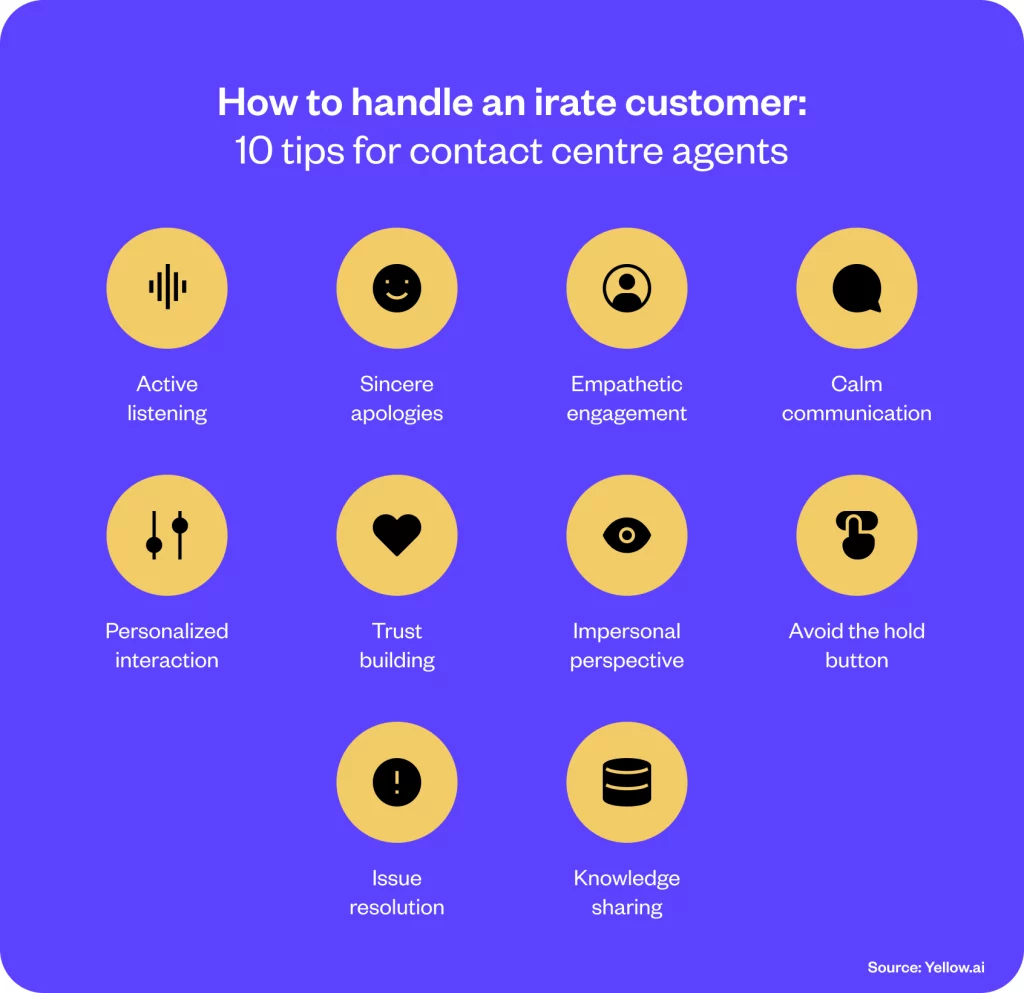
1. Active listening
Engage fully with the customer and strive to understand their perspective. Avoid repeating information or rehashing their experience, especially if they’ve already interacted with other agents. Agents can now leverage generative AI-powered Agent Assist tools to get quick summaries on customer tickets and past conversations to guide the conversation and address their concerns efficiently.
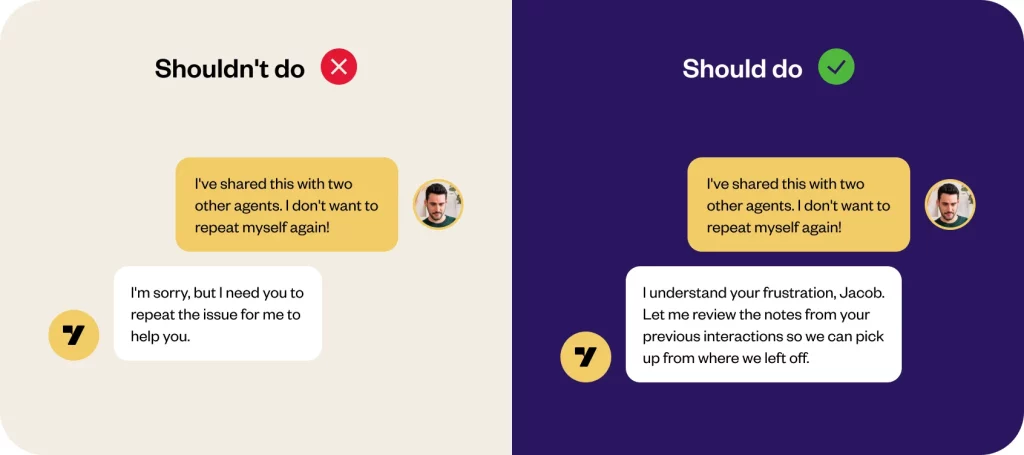
2. Sincere apologies
Offer genuine apologies to customers facing difficulties. Acknowledge the inconvenience they are facing and express empathy towards their situation. A sincere apology can go a long way in diffusing tension and building rapport with the customer.
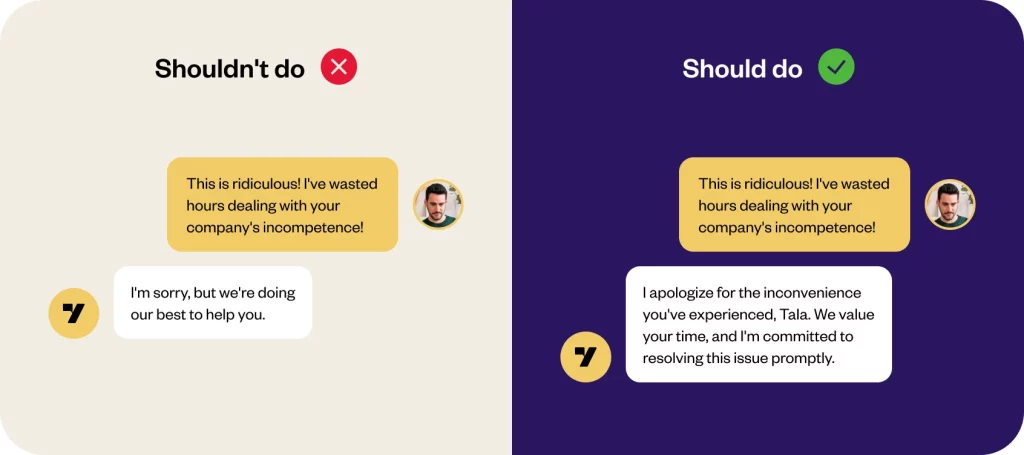
3. Empathetic engagement
Approach angry customers with empathy, validating their feelings and demonstrating understanding of their frustrations. By acknowledging their emotions, you can establish a connection and begin to work towards a resolution collaboratively. New-age generative AI Agent Assist solutions have made it possible for contact center agents to use the response and tone suggestions that best suit the context of the customer’s query. Agents can respond and handle customer queries faster with AI-powered canned response suggestions that also help them with tone suggestions. They can leverage this feature to draft a more empathetic response within seconds.
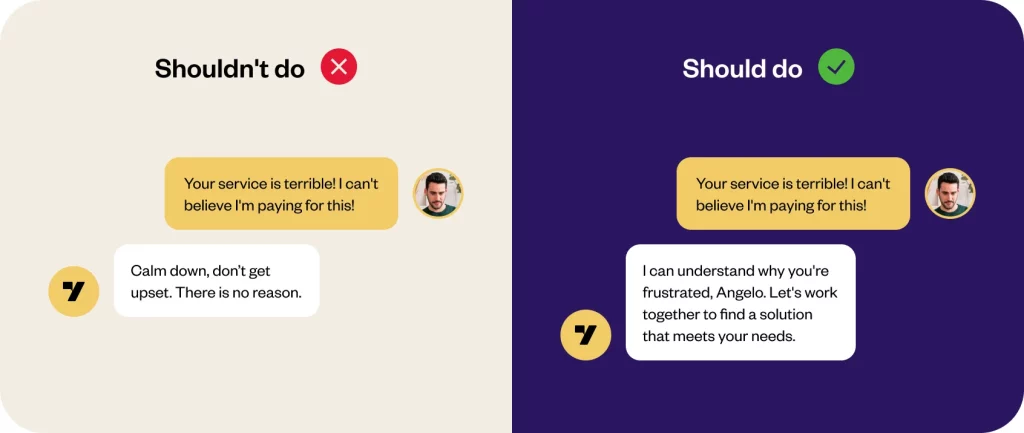
4. Calm communication
Maintain a calm and soothing tone during interactions with irate customers. Avoid escalating the situation further by responding with patience and professionalism. Your demeanor can help de-escalate tense situations and reassure customers that their concerns are being taken seriously.
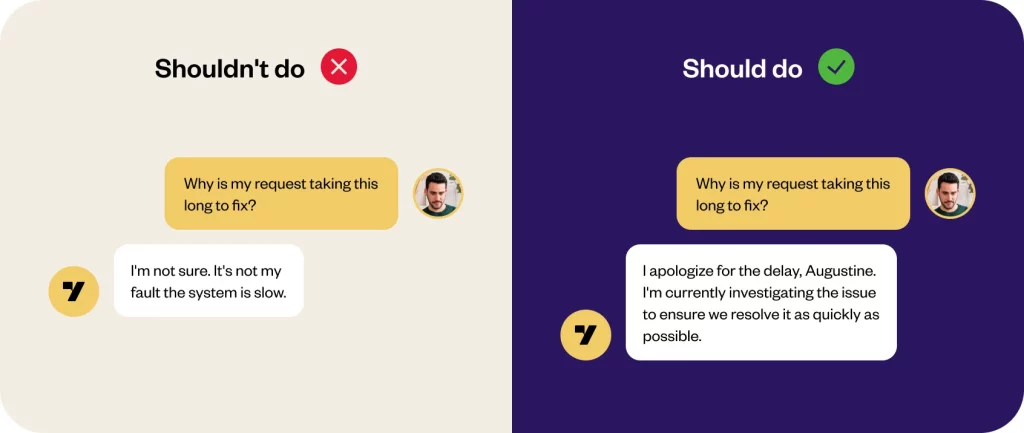
5. Personalized interaction
Use the customer’s name and personalized data to tailor the conversation to their specific needs. Leverage information from your CDP platform to demonstrate that you value their individuality and are committed to addressing their concerns effectively. For instance, referencing their purchase history or preferences can show that you’re invested in their satisfaction.
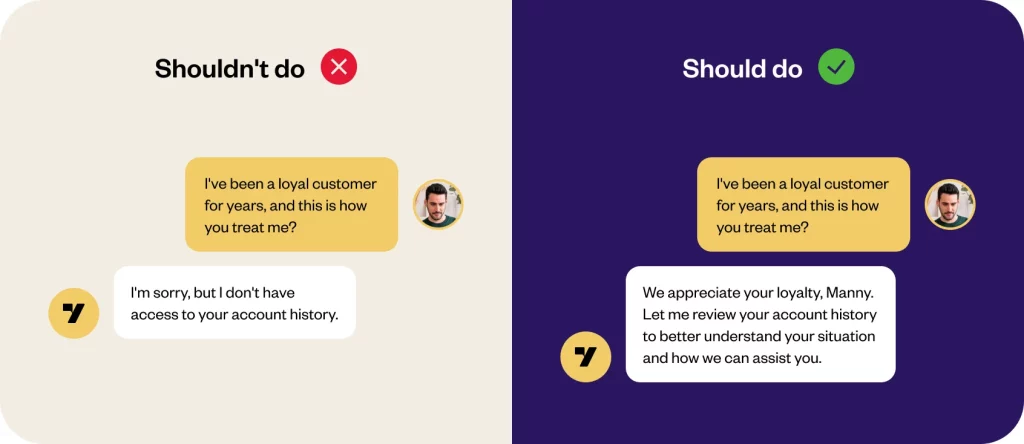
6. Trust building
Build and sustain trust throughout your interactions with customers. Be transparent about the steps you’re taking to resolve their issues and follow through on your commitments. By demonstrating reliability and accountability, you can instill confidence in the customer and foster a positive relationship.
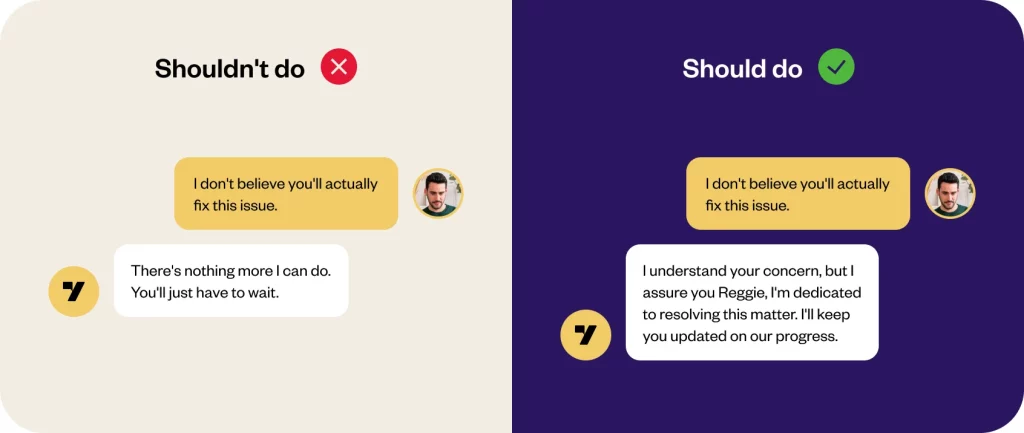
7. Impersonal perspective
Avoid taking interactions with difficult customers personally. Focus on finding solutions to their problems rather than dwelling on negative emotions. By maintaining a professional demeanor and staying objective, you can navigate challenging situations more effectively.
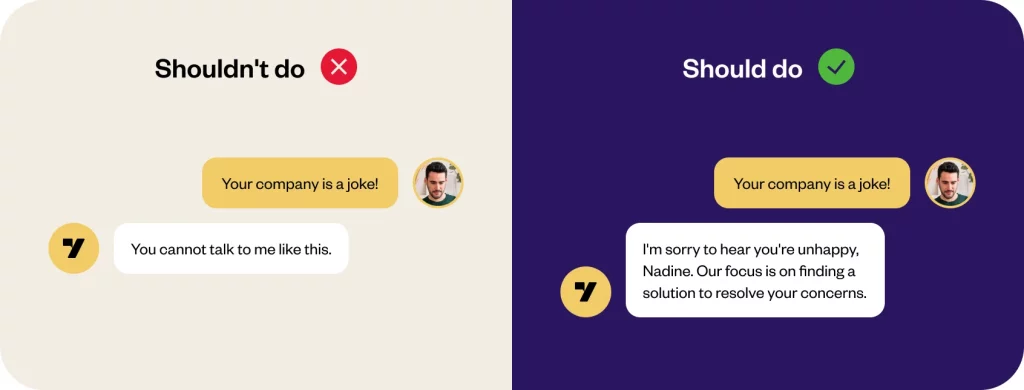
8. Avoid the hold button
Instead of putting customers on hold while you research their problem, keep them informed about your process. Provide updates on the actions you’re taking to address their concerns and involve them in the resolution process. This demonstrates transparency and keeps the customer engaged in finding a solution.
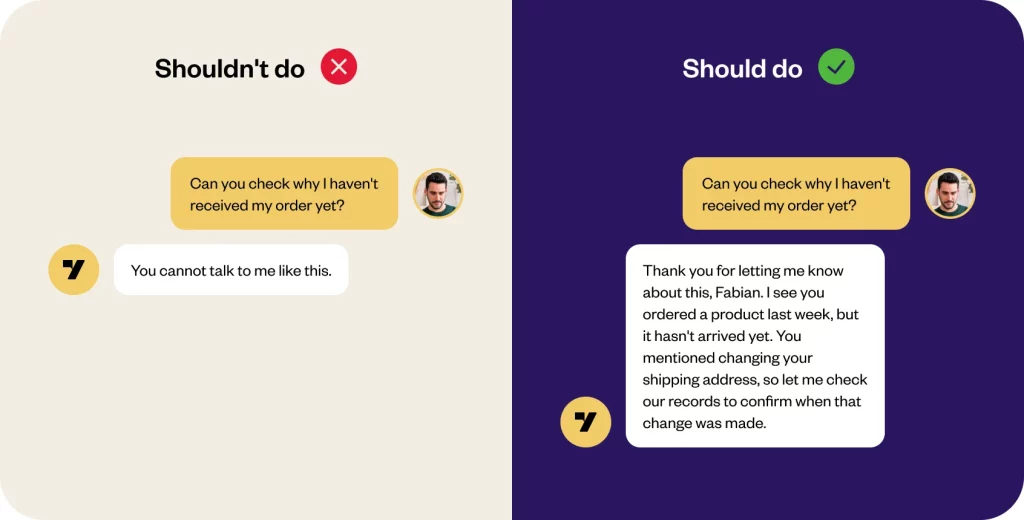
9. Issue resolution
Strive for a swift and satisfactory resolution to the customer’s issue. Keep the customer informed about the progress of their case and work towards resolving their concerns in a timely manner. By prioritizing issue resolution, you can ensure that customers feel valued and respected throughout the process.
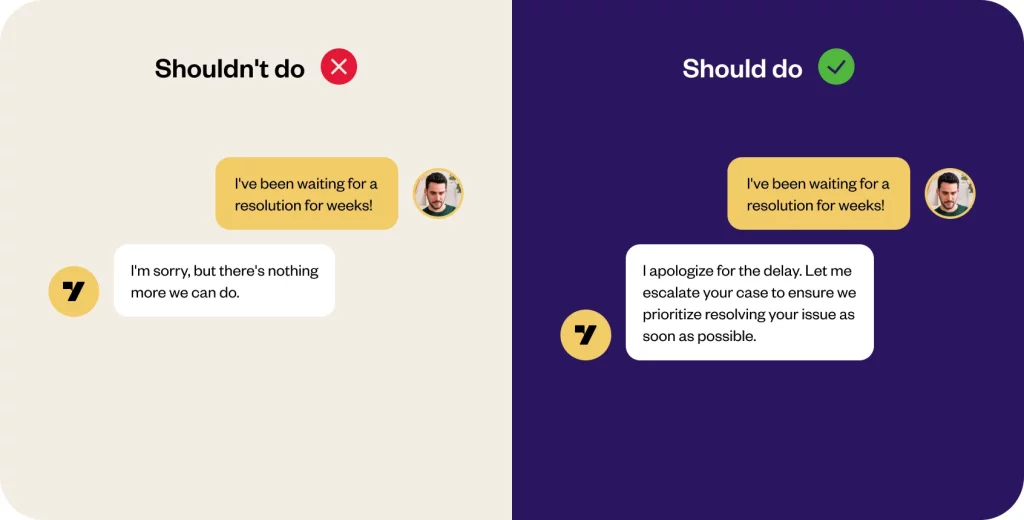
10. Knowledge sharing
Educate customers on solutions and processes to empower them with information. Provide guidance on how they can prevent similar issues in the future and offer resources to support their ongoing needs. By sharing knowledge and expertise, you can help customers feel more confident in navigating their interactions with your company.
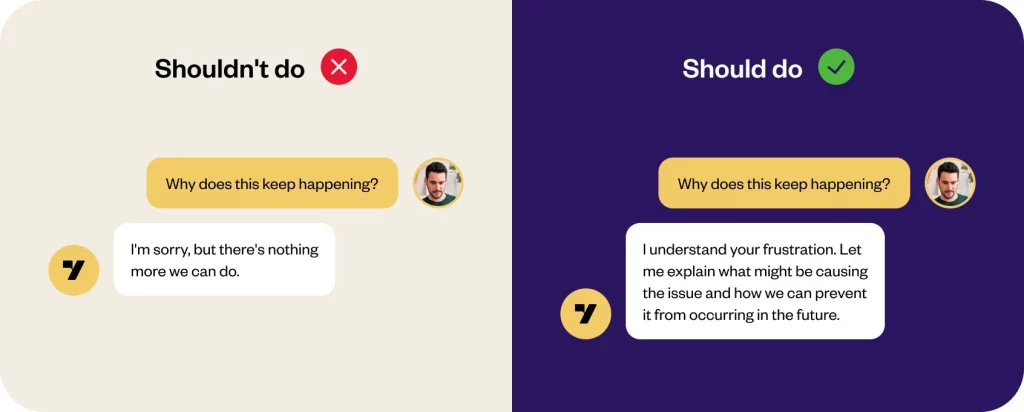
How does a subpar customer experience impact a brand?
In today’s digitally interconnected landscape, where information traverses social media and online review platforms at lightning speed, the impact of a dissatisfied customer can reverberate exponentially. Beyond mere frustration, negative interactions can tarnish the company’s brand image, leading to diminished customer perception. Losing a customer due to poor service or support doesn’t just end there; it can disrupt the entire customer journey. Confidence in the brand may wane, affecting future engagement with its products or services, ultimately diminishing customer lifetime value.
Moreover, the emotional impact of negative encounters can be lasting, leaving customers feeling undervalued. From a business perspective, the ramifications are significant, affecting revenue, customer retention rates, and market competitiveness. With organizations risking 6.7% of revenue, approximately $3.1 trillion, due to declining customer satisfaction, there’s a real threat of consumers seeking alternatives and sharing negative experiences, which can deter potential new customers.
Therefore, it is imperative for customer service teams to engage with each irate customer to the best of their ability in order to avoid a negative customer experience.
How Yellow.ai can help you automate your customer service with AI?
Yellow.ai is recognized as a leading player in the industry, delivering advanced customer support solutions and pioneering innovative approaches to customer-business interactions.
Transform your customer experiences today with Yellow.ai

Yellow.ai excels in streamlining and automating the more repetitive aspects of customer support. By automating tasks such as generating tickets, providing order updates, and responding to frequently asked questions, our platform enables contact center agents to focus on addressing complex inquiries that require personalized attention. Designed with scalability in mind, Yellow.ai’s platform allows businesses to expand their customer support capabilities without a corresponding increase in resources or expenses. This scalability ensures that businesses can uphold high standards of customer service while accommodating growth in their customer base.
Moreover, Yellow.ai’s Agent Assist feature and generative AI-powered copilots empower contact center agents by offering real-time support, guidance, and access to extensive information resources. Through analyzing customer interactions, providing tailored solutions, and continuously learning from each interaction, the Yellow.ai platform enhances both the effectiveness of agents and the satisfaction of customers.
Yellow.ai success stories

Hyundai boosts revenue and improves customer service with AI automation
Explore how Yellow.ai’s automation led to ~1000 car sales, a 10% retail conversion rate, and over 1.4 million user impressions

Pelago reimagines customer experience with generative AI powered conversational AI agents
Within a mere six weeks of going live, Pelago not only onboarded over 5,000 users but also achieved a striking 50% deflection rate!
Conclusion
Adeptly handling irate customers emerges as a cornerstone of effective customer service. With the right tools, training, and solutions, agents can navigate challenging interactions with poise and professionalism, ensuring customer satisfaction remains paramount. By fostering empathy, maintaining composure, and prioritizing issue resolution, agents can transform adversities into opportunities for customer delight. Ultimately, mastering the art of handling irate customers not only preserves brand reputation but also fosters lasting customer loyalty and advocacy, positioning businesses for sustained success in today’s competitive landscape.
Frequently asked questions (FAQs)
How do you handle an irate customer on a call?
Handling an irate customer on a call requires finesse and professionalism. Here are key strategies to address customer complaints while maintaining composure and efficacy. Firstly, it’s vital to remain composed, regardless of the situation’s intensity. Secondly, extend kindness and understanding to the caller, fostering a positive atmosphere and verbal cues. Actively listening to their concerns is pivotal, ensuring they feel heard and valued. Acknowledge the issue at hand and express genuine apologies for any inconvenience caused. While engaging with upset customers, seek to understand their perspective and concerns. Avoid making commitments beyond what can be delivered and strive for clarity in communication. Finally, consider sending a follow-up email to ensure resolution and reinforce your commitment to customer satisfaction
How do you respond to an irate customer in chat?
When addressing an irate customer via chat, it’s essential to express empathy and readiness to resolve their concerns promptly. Here are alternative ways to respond to unhappy customers through live chat:
- “Dear [Customer Name], I express regret upon learning about the issue you have encountered.Let me investigate and find a solution for you.”
- “I’m sorry to hear about your negative experience with our service. Please allow me to look into the matter and assist you accordingly.”
- “I acknowledge your frustration and apologize for any inconvenience caused. Rest assured, I’m committed to resolving this issue to your satisfaction.”
These responses convey genuine empathy and a proactive stance toward addressing the customer’s problem, aiming to alleviate tension and rebuild trust in our service.
How do you handle irate customers with an empathetic answer?
To express empathy, employ active listening techniques like nodding, rephrasing, and posing open-ended inquiries. Furthermore, employ affirmative and courteous language such as “I understand,” “I express regret,” and “Appreciate your input.” Utilize the customer’s name and appropriate pronouns, and steer clear of utilizing jargon or informal language.
How do you handle customer complaints in a script?
When managing customer complaints in a script, it’s important to start by acknowledging the customer’s concern. Here’s a template response: “Hello [Customer Name], I’ve thoroughly reviewed your complaint, and I want to extend my sincere apologies for the inconvenience caused by [Issue]. Your feedback is invaluable, and I appreciate you bringing it to my attention so we can address it promptly. Rest assured, at [Company], we treat issues like [Mention issue] with the utmost seriousness.”
How can resolving an issue efficiently lead to turning an irate customer into a loyal one?
Swift resolution of customer complaints can cultivate loyal customers and potential brand advocates. Research by Harvard Business Review reveals that customers whose complaints are addressed within five minutes display a willingness to increase their spending on future purchases. This underscores the importance of swift and efficient complaint resolution in building positive customer relationships and fostering long-term loyalty. Furthermore, such proactive measures demonstrate a commitment to customer satisfaction, enhancing the overall brand reputation and credibility.
How can customer service representatives avoid taking negative feedback from irate customers personally?
Maintain composure and refrain from disparaging remarks, recognizing that their frustration is not directed personally towards you. Engage in active listening with your customers and extend genuine apologies when warranted. Should the situation persist and cooperation becomes challenging, consider informing them that you will follow up once they have had an opportunity to compose themselves. Remember, de-escalating tensions and fostering productive dialogue are key to resolving conflicts effectively and preserving customer relationships.

























